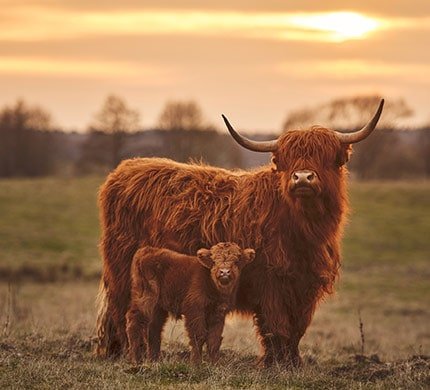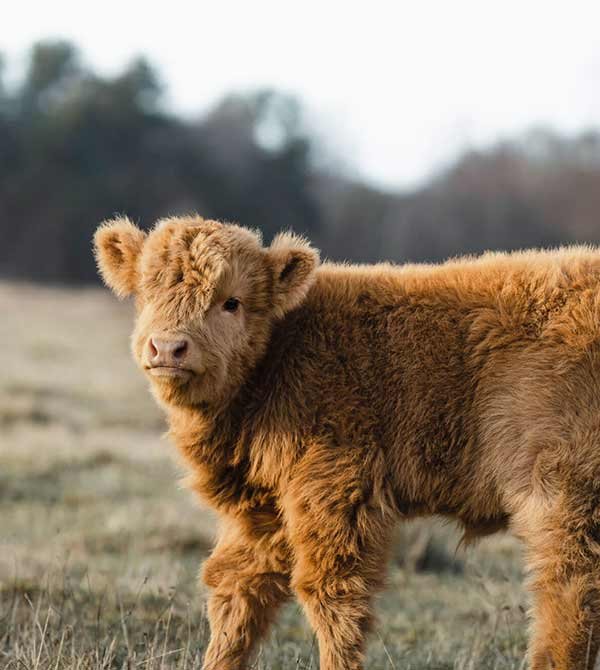Highland
- Temperature:Cold
- Milk:High in butterfat and protein
- Food:Grasses and other vegetation
- Pregnancy:Approximately 9 months
- Nationality:Scotland

General Information
Highland cattle are a hardy breed of cattle that originated in the Scottish Highlands. They are known for their long, shaggy coats, which provide excellent insulation against the cold and wet weather conditions of their native environment. Highland cattle are well-adapted to rugged terrain and are excellent grazers, able to thrive on a variety of grasses and other vegetation. While they are not typically raised for milk production, Highland cattle can produce high-quality milk that is rich in butterfat and protein. Highland cattle are often raised for their meat, which is lean and flavorful, and their hides, which are used for leather products.
In recent years, Highland cattle have gained popularity as a low-maintenance, sustainable breed that can thrive in a variety of environments. They are also known for their docile temperament and make good pets or grazing animals on small farms. Overall, Highland cattle are a unique and fascinating breed with many desirable characteristics that make them a valuable asset for farmers and ranchers.
Where we find this cow to buy?
Highland cattle can be purchased from various sources, depending on your location and specific needs. Here are some possible options for finding Highland cattle to buy:
01. Local breeders: You may be able to find Highland cattle for sale by searching for breeders in your local area. The American Highland Cattle Association (or the Highland Cattle Society, depending on your location) may have a breeder directory on their website that can help you locate breeders near you.02. Livestock auctions: Highland cattle may be sold at livestock auctions or sales events, where you can bid on the animals you're interested in purchasing. These events can be a good way to see a variety of Highland cattle in one place and compare prices.03. Online marketplaces: There are several online marketplaces that specialize in livestock sales, such as Livestock Of America or Cattle-exchange.com. These sites allow you to search for Highland cattle and connect with sellers from across the country.

How to increase milk production in Highland?
While Highland cattle are not typically raised for milk production, there are some general strategies that can be used to increase milk production in any breed of dairy cattle. Here are some possible ways to boost milk production in Highland cattle:
01
Providing Highland cattle with a higher quantity and quality of feed can help to stimulate milk production.
02
Highland cattle are well-suited to grazing, so providing them with high-quality pasture can also help to increase milk production.
03
Cows need plenty of fresh water to produce milk, so ensuring that Highland cattle have access to clean, abundant water is important.
04
Choosing bulls with high milk production genetics can help to improve the milk yield of Highland cattle over time.
Medicine
Highland cattle may require veterinary care and medication for various conditions such as infections, parasites, injuries, and other health issues. Some common types of medications that may be used for Highland cattle include:
01
AntibioticsAntibiotics may be prescribed to treat bacterial infections such as pneumonia, mastitis, and foot rot.
02
AnthelminticsAnthelmintics are medications that are used to treat parasitic infections such as worms and external parasites like lice or mites.
03
Nonsteroidal Anti-inflammatory DrugsNSAIDs may be used to treat pain and inflammation caused by injuries or conditions like arthritis.
04
Topical TreatmentsTopical treatments such as antiseptics or wound dressings may be used to treat injuries or skin conditions such as dermatitis or mange.
Pregnancy
The gestation period for Highland cattle is typically around 285 days, or about 9.5 months. During pregnancy, Highland cows should be provided with adequate nutrition and proper care to ensure the health of both the cow and calf.
Some things to keep in mind during pregnancy in Highland cattle include:
01
NutritionDuring pregnancy, Highland cows require a well-balanced diet that provides adequate protein, energy, and minerals. This may include hay, grass, silage, and supplements as needed.
02
ExerciseThey should be allowed to move freely and get adequate exercise during pregnancy, which can help to maintain their health and prepare them for calving.
03
Veterinary CareThey should receive regular veterinary care during pregnancy, including prenatal checks and vaccinations as needed. Any health issues or concerns should be addressed promptly.
04
Calving PreparationAs the due date approaches, Highland cows should be monitored closely for signs of labor. They should be provided with a clean, dry area to give birth and should be checked frequently during the calving process to ensure that everything is going smoothly.
Important!
It’s important to do your research and ensure that you’re purchasing Highland cattle from a reputable source. Look for breeders with a good reputation, who can provide information about the animal’s genetics, health, and history. It’s also a good idea to have a veterinarian or experienced cattle handler inspect the animals before purchasing them.
Food
Highland cattle are primarily grazers, meaning they primarily eat grass and other forages. Their diet may vary depending on the season and availability of food, but typically includes:
They are well-adapted to grazing on rough, hilly terrain and can thrive on a variety of grasses, including native grasses and other forages.
Silage is a type of fermented grass or other forages that can be stored and fed to cattle during the winter months.
Depending on the quality of the grass or forages available, Highland cattle may require supplements to meet their nutritional needs.
They may enjoy occasional treats such as apples, carrots, or other fruits and vegetables, but these should not make up a significant portion of their diet.
Facts
Here are some interesting facts about Highland cattle:
They are a popular breed for agricultural shows and competitions, where they are judged on criteria such as appearance, temperament, and overall health.
Highland cattle are known for their long, shaggy hair, which provides insulation in cold weather and protection from the sun and insects in warm weather.
Highland cattle have long, curved horns that can grow up to 4 feet in length. The horns are used for defense and foraging.
Highland cattle are excellent grazers and can thrive on rough, hilly terrain that other breeds may find difficult to navigate.
Highland cattle are known for their docile temperament and are often used for beef production.
They are slow to mature and typically reach market weight at around 2-3 years of age.
They are a hardy breed that is well adapted to cold and wet climates. They originated in the Scottish Highlands.
They have a distinctive vocalization, which is a low-pitched “moo” that is said to sound like a bagpipe.